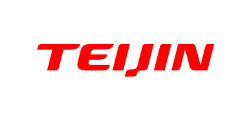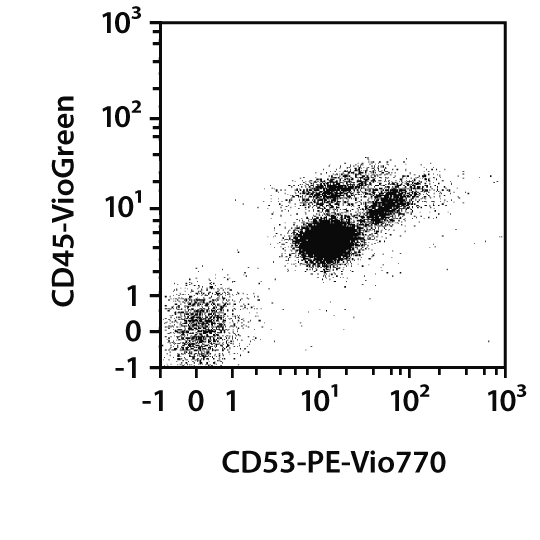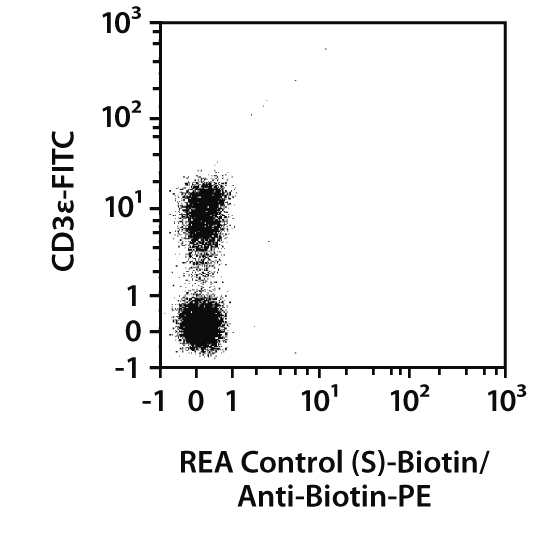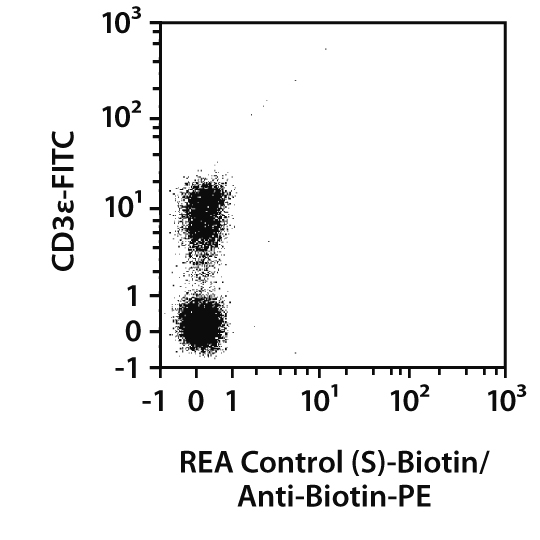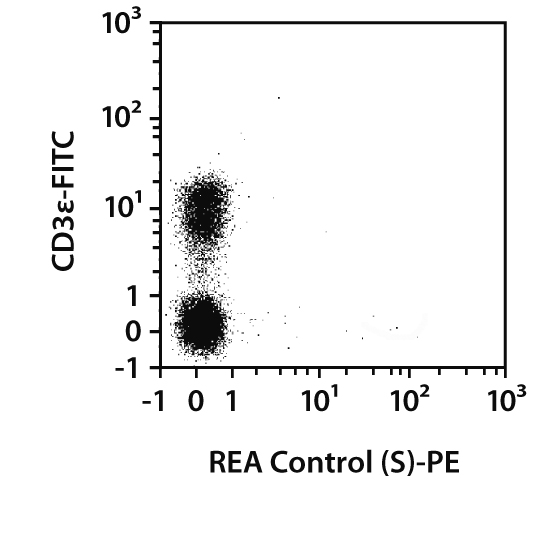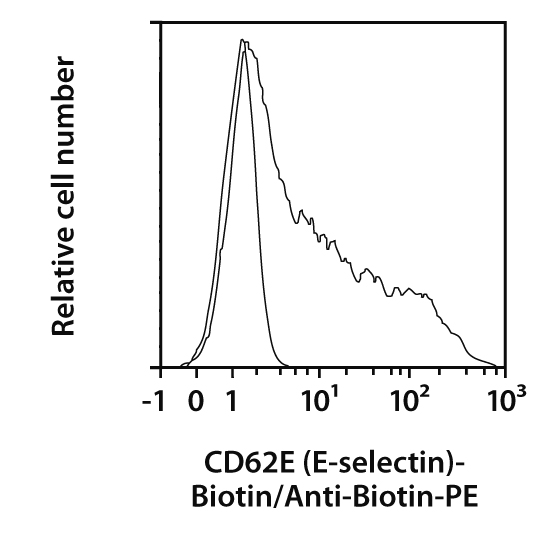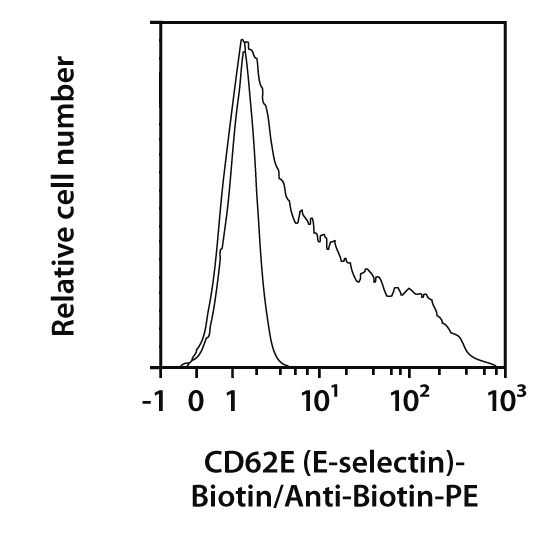Recombinant antibody
Code: 130-101-817
Overview
Clone REA259 recognizes the CD53 antigen, a 35–42 kDa type II transmembrane glycoprotein, which is also known as tetraspanin-25. CD53 is expressed on all leukocytes including plasma cells, but not on platelets, erythrocytes, and non-hematopoietic tissues. CD53 mediates oxidative burst in monocytes and has been shown to interact with a number of proteins including IL-4, CD20, CD2, CD9, IL-2, VLA-4, and CD4. Cross-linking of CD53 on monocytes induces a strong increase in intracellular calcium ions, whereas a modest increase is seen in B lymphocytes. In resting B cells, the molecule transmits a co-stimulatory signal and promotes activation through the Ig receptor.
Additional information: Clone REA259 displays negligible binding to Fc receptors.
Alternative names
MOX44, TSPAN25Specifications
Code: 130-104-592
Overview
Clone REA311 recognizes the murine CD6 antigen, a Single-pass type I membrane protein which is expressed on most CD4+CD8+ double-positive, CD4+ or CD8+ single-positive thymocytes, and at highest levels on mature CD3+ thymocytes. In marked contrast to human CD6, mouse CD6 has a long cytoplasmic tail that is not closely related to other proteins. CD6 functions as an adhesion molecule as well as costimulatory molecule for TCR-mediated T cell activation. In thymocytes that express heterogeneous TCR, CD6 increases occur as double-positive thymocytes are selected to a single-positive stage. In contrast, in thymocytes from TCR transgenic mice, CD6 is barely increased following selection, suggesting that as functional avidity increases, requirements for CD6-dependent co-stimulation decrease. During thymic development CD6-dependent signals may contribute both to thymocyte survival, and to the overall functional avidity of selection.
Additional information: Clone REA311 displays negligible binding to Fc receptors.
Alternative names
T-cell differentiation antigen CD6Specifications
- Biotin : 0
- Mouse : 0
- 200 tests : 0
- 30 µg in 1 mL : 0
- Recombinant Human IgG1 : 0
Code: 130-104-664
Overview
Clone REA302 recognizes the human CD312 antigen, a multi-pass membrane protein also known as EGF-like module-containing mucin-like hormone receptor-like 2 (EMR2) which shares strikingly similar molecular characteristics with CD97. CD312 is a member of the epidermal growth factor-seven transmembrane (EGF-TM7) family of proteins expressed predominantly by cells of the immune system. CD312 fails to interact with CD55, the cellular ligand for CD97, suggesting the possibility of different cellular ligands. CD312 interacts with chondroitin sulphate glycosaminoglycans in an isoform-specific manner. Expression of CD312 is up-regulated during differentiation and maturation of macrophages, and is conversely down-regulated during dendritic cell maturation. In monocytes and macrophages, CD312 can be specifically up-regulated by LPS and interleukin 10 (IL-10) via an IL-10–mediated pathway. In inflamed tissues, CD312 is detected in subpopulations of myeloid cells including macrophages and neutrophils. CD312 plays a role in the migration and adhesion of myeloid cells during cell differentiation, maturation, and activation.
Additional information: Clone REA302 displays negligible binding to Fc receptors.
Alternative names
ADGRE2, EMR2Specifications
- Biotin : 0
- Mouse : 0
- 60 tests : 0
- 9 µg in 300 µL : 0
- Recombinant Human IgG1 : 0
Code: 130-104-594
Overview
Clone REA311 recognizes the murine CD6 antigen, a Single-pass type I membrane protein which is expressed on most CD4+CD8+ double-positive, CD4+ or CD8+ single-positive thymocytes, and at highest levels on mature CD3+ thymocytes. In marked contrast to human CD6, mouse CD6 has a long cytoplasmic tail that is not closely related to other proteins. CD6 functions as an adhesion molecule as well as costimulatory molecule for TCR-mediated T cell activation. In thymocytes that express heterogeneous TCR, CD6 increases occur as double-positive thymocytes are selected to a single-positive stage. In contrast, in thymocytes from TCR transgenic mice, CD6 is barely increased following selection, suggesting that as functional avidity increases, requirements for CD6-dependent co-stimulation decrease. During thymic development CD6-dependent signals may contribute both to thymocyte survival, and to the overall functional avidity of selection.
Additional information: Clone REA311 displays negligible binding to Fc receptors.
Alternative names
T-cell differentiation antigen CD6Specifications
- PE : 0
- Mouse : 0
- 200 tests : 0
- 30 µg in 1 mL : 0
- Recombinant Human IgG1 : 0
Code: 130-104-666
Overview
Clone REA302 recognizes the human CD312 antigen, a multi-pass membrane protein also known as EGF-like module-containing mucin-like hormone receptor-like 2 (EMR2) which shares strikingly similar molecular characteristics with CD97. CD312 is a member of the epidermal growth factor-seven transmembrane (EGF-TM7) family of proteins expressed predominantly by cells of the immune system. CD312 fails to interact with CD55, the cellular ligand for CD97, suggesting the possibility of different cellular ligands. CD312 interacts with chondroitin sulphate glycosaminoglycans in an isoform-specific manner. Expression of CD312 is up-regulated during differentiation and maturation of macrophages, and is conversely down-regulated during dendritic cell maturation. In monocytes and macrophages, CD312 can be specifically up-regulated by LPS and interleukin 10 (IL-10) via an IL-10–mediated pathway. In inflamed tissues, CD312 is detected in subpopulations of myeloid cells including macrophages and neutrophils. CD312 plays a role in the migration and adhesion of myeloid cells during cell differentiation, maturation, and activation.
Additional information: Clone REA302 displays negligible binding to Fc receptors.
Alternative names
ADGRE2, EMR2Specifications
- PE : 0
- Mouse : 0
- 60 tests : 0
- 9 µg in 300 µL : 0
Code: 130-104-642
Overview
Clone REA280 recognizes the CD62 antigen-like family member E (CD62E) antigen, a 115 kDa single-pass type I membrane protein which is also known as E-selectin, endothelial-leukocyte adhesion molecule 1 (ELAM-1), or leukocyte-endothelial cell adhesion molecule 2 (LECAM2). CD62E is a cell adhesion molecule highly expressed only on endothelial cells activated by cytokines. It is not stored in the cell and has to be transcribed, translated, and transported to the cell surface. The production of CD62E is stimulated by the expression of CD62P which is stimulated by tumor necrosis factor α, and it can also be stimulated by interleukin-1 and lipopolysaccharide. CD62E recognizes and binds to sialylated carbohydrates present on the surface proteins of certain leukocytes. CD62E ligands are expressed by neutrophils, monocytes, eosinophils, memory-effector T-like lymphocytes, and natural killer cells. Each of these cell types is found in acute and chronic inflammatory sites in association with expression of CD62E, thus implicating CD62E in the recruitment of these cells to such inflammatory sites.
Additional information: Clone REA280 displays negligible binding to Fc receptors.
Alternative names
SELE, Elam, ESEL, LECAM2, ELAM-1, E-selectinSpecifications
- Human : 0
- Biotin : 0
- 100 tests : 0
- 1 mL : 0
- Recombinant Human IgG1 : 0
Code: 130-104-683
Overview
Clone REA280 recognizes the CD62 antigen-like family member E (CD62E) antigen, a 115 kDa single-pass type I membrane protein which is also known as E-selectin, endothelial-leukocyte adhesion molecule 1 (ELAM-1), or leukocyte-endothelial cell adhesion molecule 2 (LECAM2). CD62E is a cell adhesion molecule highly expressed only on endothelial cells activated by cytokines. It is not stored in the cell and has to be transcribed, translated, and transported to the cell surface. The production of CD62E is stimulated by the expression of CD62P which is stimulated by tumor necrosis factor α, and it can also be stimulated by interleukin-1 and lipopolysaccharide. CD62E recognizes and binds to sialylated carbohydrates present on the surface proteins of certain leukocytes. CD62E ligands are expressed by neutrophils, monocytes, eosinophils, memory-effector T-like lymphocytes, and natural killer cells. Each of these cell types is found in acute and chronic inflammatory sites in association with expression of CD62E, thus implicating CD62E in the recruitment of these cells to such inflammatory sites.
Additional information: Clone REA280 displays negligible binding to Fc receptors.
Alternative names
SELE, Elam, ESEL, LECAM2, ELAM-1, E-selectinSpecifications
- Human : 0
- Biotin : 0
- 30 tests : 0
- 0.3 ml : 0
- Recombinant Human IgG1 : 0
Code: 130-104-643
Overview
Clone REA280 recognizes the CD62 antigen-like family member E (CD62E) antigen, a 115 kDa single-pass type I membrane protein which is also known as E-selectin, endothelial-leukocyte adhesion molecule 1 (ELAM-1), or leukocyte-endothelial cell adhesion molecule 2 (LECAM2). CD62E is a cell adhesion molecule highly expressed only on endothelial cells activated by cytokines. It is not stored in the cell and has to be transcribed, translated, and transported to the cell surface. The production of CD62E is stimulated by the expression of CD62P which is stimulated by tumor necrosis factor α, and it can also be stimulated by interleukin-1 and lipopolysaccharide. CD62E recognizes and binds to sialylated carbohydrates present on the surface proteins of certain leukocytes. CD62E ligands are expressed by neutrophils, monocytes, eosinophils, memory-effector T-like lymphocytes, and natural killer cells. Each of these cell types is found in acute and chronic inflammatory sites in association with expression of CD62E, thus implicating CD62E in the recruitment of these cells to such inflammatory sites.
Additional information: Clone REA280 displays negligible binding to Fc receptors.
Alternative names
SELE, Elam, ESEL, LECAM2, ELAM-1, E-selectinSpecifications
- Human : 0
- Biotin : 0
- 30 tests : 0
- 0.3 ml : 0
- Recombinant Human IgG1 : 0



